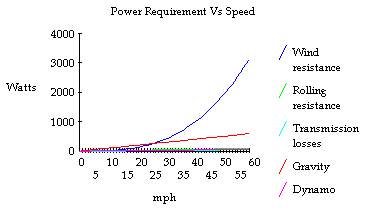
A question for all you powertappers out there, or just anyone who understands this stuff better than me. Let me give you a real life scenario and tell me which direction the power is going. I am speaking in generals here, lets not try to slice the bologna too thin.
I am 15 miles into a 40 mile ride on a road with a slight incline. I am traveling at 22 mph on my Valdora PHX and have been for a mile with this same terrain. I don't know my cadence but I am in the big chainring up front and half way down on the back. My legs start to get tired and speed drops to 21 mph, I increase my cadence and back up I go to 22 mph. After another mile my mph start to drop more often, so I downshift to an easier gear, my cadence comes up and so does my mph back to 22. Now I am travelling at the same mph (22) but in a easier gear with higher cadence.I am interested in the wattage aspect of this story problem. Lets say for the sake of arguing that my watts at 22 mph during the mile is 120. As my cadence drops and my mph suffers the wattage is going down, correct?
So does that mean when I stay in the same gear and increase my cadence to get back to 22 mph, my wattage went up?
When I drop a gear and maintain 22 mph, my turnover is higher and resistance against my legs is lower. What has my wattage done, gone up or gone down?

3 comments:
check out this link to help answer your questions.
http://www.mayq.com/Best_european_trips/Cycling_speed_math.htm
No power here, but that's a damn sexy bike. :)
Here's the analytical answer ;-)
Power should stay the same in the situation you describe, and here's why:
Power (P) equals the sum of total Work (W) done over a period of time (delta T). On a bike, the factors that contribute to the total Work are: Velocity * [Aero Drag Force + Inertial Force + Rolling Resistance Force] PLUS the quantity of Work conducted due to Gravity and Friction in the drivetrain.
The beauty of Power derived from rotational systems is that it can also be expressed simply as a product of Torque (T) and angular velocity (w) (this product being used to quantify the work required to overcome all of the aforementioned paramters).
Anyways, in your example, you're riding some stretch of road where, presumably, the terrain isn't changing at all, and we're assuming your position also isn't changing (drag) and there'd be no reason for your rolling resistance, drivetrain friction, or inertia to be changing either (the latter because you're not accelerating). As such, Power becomes only a function of steady-state Velocity (over time), and because:
P = V and P = T x w
We see that V = T x w, or in other words, at constant power, your speed is proportional to your torque times your cadence. So if you're trying to keep your speed constant at 22mph and you drop your cadence, you need to up your torque. Likewise, if you're keeping 22mph and you drop your torque, you need to increase your cadence.
And then there's that whole issue Bolder brings up about why his power reading shows a drop on the trainer... We'll save that convo for another day ;-)
Have fun!
Post a Comment